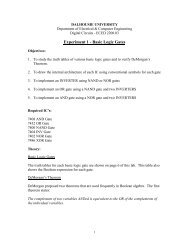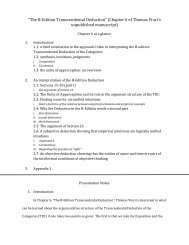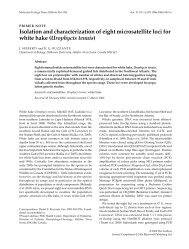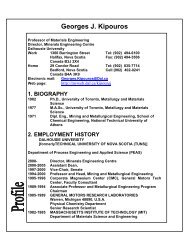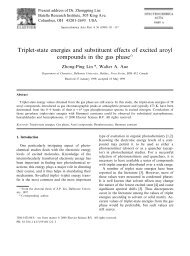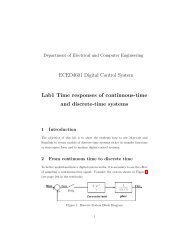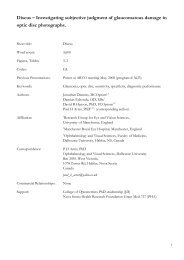Short bio of Talan ˙Iscan (“EeshJohn”) Requirements Course ...
Short bio of Talan ˙Iscan (“EeshJohn”) Requirements Course ...
Short bio of Talan ˙Iscan (“EeshJohn”) Requirements Course ...
You also want an ePaper? Increase the reach of your titles
YUMPU automatically turns print PDFs into web optimized ePapers that Google loves.
<strong>Requirements</strong><br />
International Finance – Econ 3331<br />
General introduction<br />
<strong>Talan</strong> ˙I¸scan<br />
Dalhousie University<br />
Fall 2012<br />
• Two midterm examinations (in class): 25% <strong>of</strong> final<br />
grade each<br />
• Five Assignments: 20% <strong>of</strong> final grade<br />
→ front-loaded; data driven<br />
• Final examination (date and place TBA): 30% <strong>of</strong> final<br />
grade<br />
1.3<br />
<strong>Short</strong> <strong>bio</strong> <strong>of</strong> <strong>Talan</strong> ˙I¸scan (<strong>“EeshJohn”</strong>)<br />
• Generation: born right after the (Canadian) baby boom<br />
• At Dalhousie since 1994<br />
• Regularly teach macroeconomics and international eco-<br />
nomics<br />
• Research interests: macroeconomics, international fi-<br />
nance, and economic development<br />
<strong>Course</strong> material: myweb/dal.ca/tiscan<br />
1. Lecture notes → course website<br />
2. Lecture presentations → course website<br />
3. Assignments → course website<br />
4. Research articles → Dalhousie Libraries<br />
5. Econ Databases → dal.ca.libguides.com/economics<br />
1.2<br />
1.4
Lecture content<br />
Motivation and building foundations<br />
1. Issue: why do we care?<br />
2. Formal modeling<br />
3. Discussion: critical thinking and assessment<br />
4. Independent learning<br />
“What”s <strong>of</strong> this course<br />
• Globalization <strong>of</strong> production: tariffs, transportation costs<br />
≈ 8% annual growth in international trade (1950–2000)<br />
• Globalization <strong>of</strong> finance: capital controls, saving<br />
differences; financial instability<br />
• Globalization <strong>of</strong> labour markets: immigration, <strong>of</strong>fshoring<br />
<strong>of</strong> jobs and tasks<br />
1.5<br />
1.7<br />
Ground rules<br />
• Attendance to lectures: effortful cognitive work<br />
• Turn <strong>of</strong>f your cell-phones – put them away<br />
• No electronic devices<br />
• Work on the assignments<br />
Major net exporters and importers <strong>of</strong> capital, 2010<br />
Economies that export, % Economies that import, %<br />
China 20.91 Turkey 4.14<br />
Japan 13.30 India 4.18<br />
Germany 12.03 France 4.53<br />
Switzerland 5.09 United Kingdom 4.78<br />
Russia 4.88 Spain 5.40<br />
Netherlands 3.81 Italy 6.14<br />
Norway 3.64 United States 40.12<br />
Singapore 3.38 Other economies 30.72<br />
Kuwait 2.85<br />
Taiwan PC 2.77<br />
Saudi Arabia 2.65<br />
Sweden 2.02<br />
Korea 1.93<br />
Other economies 20.74<br />
Source: IMF, Global Financial Stability Report, April 2011.<br />
www.imf.org/external/pubs/ft/gfsr/2011/01/index.htm<br />
1.6<br />
1.8
“Who wants to be a triple billionaire?”<br />
By the end <strong>of</strong> 2010, China’s foreign-exchange reserves ex-<br />
ceeded 2.8 trillion U.S. dollars<br />
What can you afford with this much wealth?<br />
See The Economist (14 April 2011)<br />
www.economist.com/node/18560525<br />
Exchange rate classifications, 1974–2007<br />
1.9<br />
1.11<br />
“Why”s <strong>of</strong> this course<br />
1. Determination <strong>of</strong> the exchange rate in the short and<br />
medium run (3 weeks)<br />
2. Monetary and fiscal policies in small open economies (4<br />
weeks)<br />
3. Risk-sharing in the international economy (4 weeks)<br />
1.10



